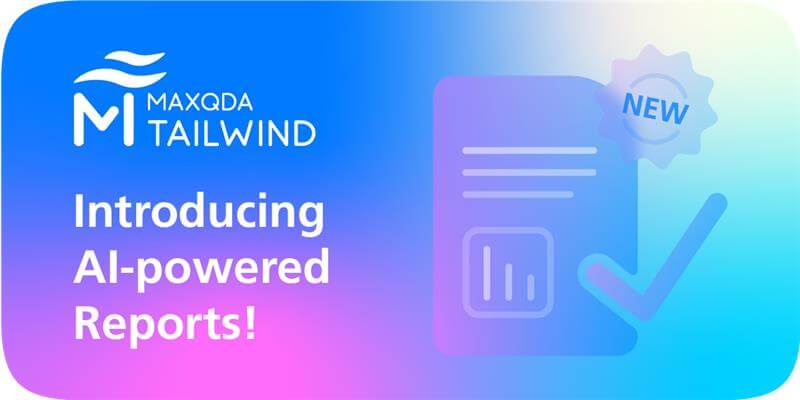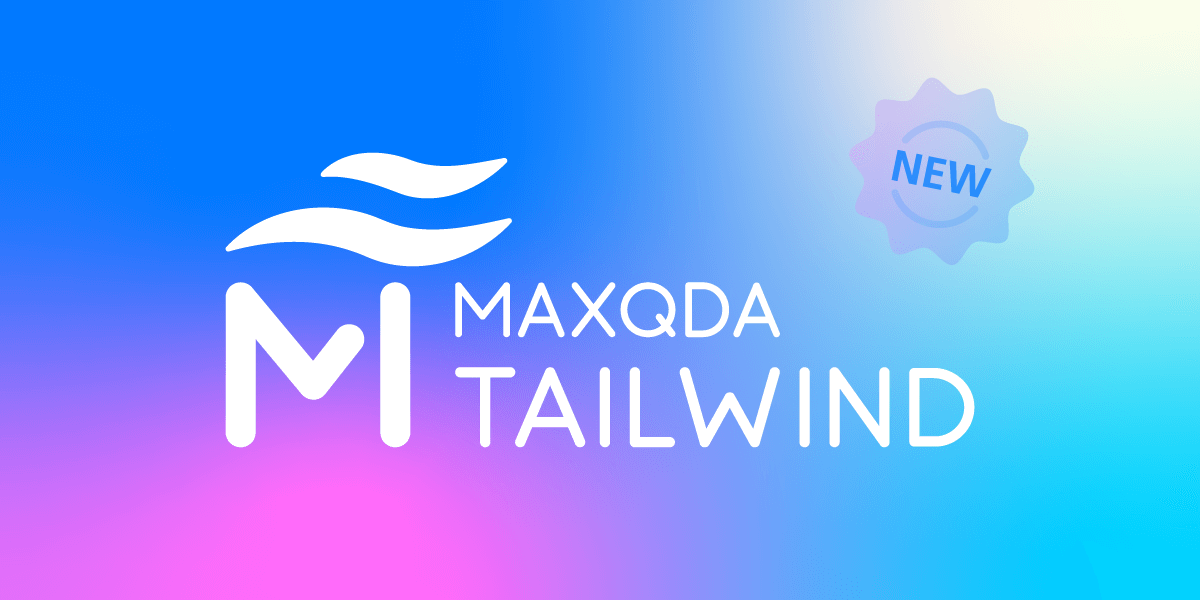MAXQDA Tailwind graduated from its beta phase.
You can now experience MAXQDA Tailwind as a standalone web app – meaning you can access it anytime, anywhere — independently of MAXQDA and AI Assist.
Transcribing interviews and conversations is one of the most time-consuming tasks in qualitative research. With MAXQDA, this process is significantly more efficient: You can automatically transcribe interviews and other conversations in over 50 languages – either directly in MAXQDA or via the web application (without a MAXQDA license).
However, with new technical possibilities come new questions: What about data protection when automatically processing interviews with MAXQDA Transcription? What consent do you need from your research participants? How can you ensure GDPR compliance in your research?
Please note: This post focuses on data protection as it relates to the GDPR (General Data Protection Regulation). If you are based outside of the EU, please check which data protection rules apply to you.
Legal Basis: Informed Consent
When automatically transcribing interviews, two key aspects of the General Data Protection Regulation (GDPR) must be considered:
- Under Art. 4 No. 14, voice recordings are classified as biometric data, as they capture physical, physiological, or behavioral characteristics that allow for unique identification of individuals. This places them under the special categories of personal data governed by Art. 9.
- To process such sensitive data, you typically need explicit consent from the interviewee (Art. 9 Para. 2a). This consent must clearly establish that the individual:
- Has been fully informed about the specific purpose of the recording
- Has explicitly agreed to automatic transcription
- Is participating in the research voluntarily
Consent must be obtained prior to beginning the interview recording. For research projects, written consent is strongly recommended as it provides necessary documentation.
Essential Elements of a Consent Form
A properly structured written consent form should include these elements:
- Interviewee’s full name
- Date of interview
- Research subject and scope
- Names of individuals responsible for research and data processing
- Types of data being collected
- Details of all data processing methods (recording, transcription, anonymization, analysis, storage, etc.)
- Purpose of data processing
- Information about the right to withdraw consent
- Confirmation of voluntary participation
- Date and signature of the interviewee
Ideally, the declaration is structured in two parts: the information section and the consent section.
Suggested Wording for the Consent Form
Based on these legal principles, here’s a concrete suggestion for how you can include automatic transcription in your consent form:
Information Section
…
The interview will be recorded.
The recording will be automatically transcribed using MAXQDA Transcription, an online service provided by VERBI GmbH, Invalidenstr. 74, 10557 Berlin. All processing occurs under our instruction and on our behalf in accordance with Art. 28 GDPR and our data processing agreement. Transcription takes place exclusively on servers within the EU (Germany and the Netherlands). The interview recording will be permanently deleted from the online service immediately after transcription is complete.
…
Consent Section
…
I consent to the interview being recorded as described above.
⭘ Yes ⭘ No
I consent to the automatic transcription of my interview recording as described above.
⭘ Yes ⭘ No
or as a combined option:
I consent to the recording and automatic transcription of my interview as described above.
⭘ Yes ⭘ No
…
To create a legally compliant consent form, you should inform participants about other important areas of data processing and obtain consent for these as well:
The following areas should be included:
- Nature and timing of anonymization
- Description of the analysis process and the people involved
- Duration and form of data storage
- Handling of anonymized content in publications and presentations
Optional additions:
- Archiving of data
- Use in research colloquiums
- Option for participants to review the transcripts
Sample Consent Form Resources
Here are two valuable examples of established consent forms:
- For social science research: Comprehensive template with detailed participant information (Qualiservice, University of Bremen)
- For medical research: Comprehensive template for patient consent, developed in collaboration with German data protection authorities (Medical Informatics Initiative)
Both resources are available in English and German. You can adapt these templates and integrate the specific details about automatic transcription with MAXQDA for your research needs.
Special Case: Publicly Available Data
When working with recordings that have been made publicly available, explicit consent from the individuals featured is not required. According to Art. 9 Para. 2e GDPR, this exemption applies to data that has been “manifestly made public,” for example:
- Political debate panels
- YouTube videos
- Public podcasts
- Press statements and releases
Important Qualification
This exemption must be applied with careful case-by-case consideration. Not all publicly accessible content automatically qualifies as “manifestly made public.” The critical determining factor is whether the content was intentionally directed at a public audience. Even publicly available recordings may require consent in certain circumstances if they were not explicitly intended for public consumption.
Ethical Considerations and Legal Obligations
Even when formal consent is not required, researchers should observe these ethical and legal principles:
- Properly attribute and cite all recording sources
- Ensure statements are fairly represented in their proper context
- Consider the potential implications of your research, particularly for sensitive topics
- Comply with the terms of service of platforms hosting the recordings
Do I Need Consent for AI-Assisted Analysis?
If you plan to use the AI capabilities of MAXQDA AI Assist or MAXQDA Tailwind to analyze your transcribed interviews, here are the key considerations:
- Fully anonymized data: No additional consent is required as this data is no longer subject to GDPR regulations.
- Important distinction: Pseudonymization (replacing names with codes or aliases) is not equivalent to complete anonymization under GDPR guidelines.
- Non-anonymized data: You must inform participants and obtain their explicit consent for AI-assisted analysis.
If you’re working with non-anonymized or pseudonymized data, consider adding these clauses to your consent form:
Information Section
For analyzing the transcribed interviews, we will utilize the AI-assisted tool MAXQDA AI Assist/Tailwind provided by VERBI GmbH, Invalidenstr. 74, 10557 Berlin. All processing occurs under our direct instruction and on our behalf in accordance with Art. 28 GDPR and our established data processing agreement. Processing takes place exclusively on servers within the European Union. The data is processed temporarily for analytical purposes only, is not permanently stored, and is never used to train AI models.
Consent Section
I consent to the analysis of my transcribed interview using AI-assisted tools as described above.
⭘ Yes ⭘ No
In Detail: Data Processing and Security with MAXQDA Transcription
To communicate transparently with your research participants, it’s valuable to understand exactly how MAXQDA Transcription handles audio and video files. Here’s a comprehensive overview of the technical workflow:
- Upload Stage: Your audio and video files are uploaded to a secure MAXQDA server located in Frankfurt, Germany (hosted by Amazon Web Services)
- Processing Stage: Transcription processing occurs on dedicated servers in the Netherlands
- Deletion Protocol:
- Audio and video files are removed from the MAXQDA server immediately once transcription processing begins
- Original files are deleted from the transcription server upon completion of the transcription
- The completed transcript is temporarily cached on the MAXQDA server in Frankfurt and automatically purged 7 days after download
MAXQDA ensures data protection and security through these key measures:
- All servers are physically located within EU borders and operate in full GDPR compliance
- All data transmission is secured through encryption protocols
- VERBI (MAXQDA’s developer) maintains formal data processing agreements with all service providers
- When you accept VERBI’s terms and conditions as a purchaser and user of the software, you automatically establish a data processing agreement with VERBI
For additional information regarding data protection and security protocols for automatic transcription with MAXQDA Transcription, please consult the Online Manual.
Try MAXQDA (Includes 1 hour of automatic transcription
Conclusion: Conduct GDPR-Compliant and Efficient Research with MAXQDA Transcription
Automatic transcription with MAXQDA delivers substantial time savings for your research workflow. With appropriate preparation, you can ensure full data protection compliance:
✓ When working with private research data:
- Secure properly structured written consent forms
- Maintain full transparency about all data processing methods
- Implement thorough anonymization protocols for all transcripts
✓ When working with publicly available data:
- Verify platform-specific terms of service and evaluate each case individually
- Maintain comprehensive documentation of all sources
- Adhere to established research ethics principles
- Provide clear information about your processing methods
Disclaimer: The information presented has been thoroughly researched and compiled with the utmost care. It is intended to serve as a helpful guide but does not constitute legal advice. We cannot guarantee complete accuracy or comprehensiveness regarding legal aspects. This disclaimer extends to the external resources we’ve linked, for which we bear no responsibility and cannot guarantee legal compliance.



